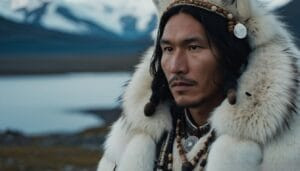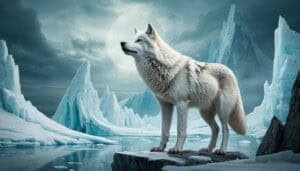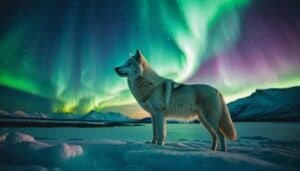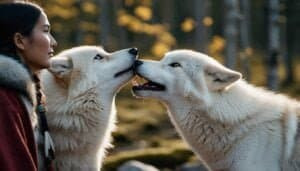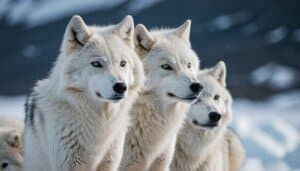Introduction
Arctic wolves, with their haunting howls, hold a profound place in Arctic beliefs. This article delves into the spiritual significance of these howls, exploring their role in mythology, the symbolic meanings attributed to them, and how Arctic communities interpret these vocalizations
We will examine the connection between wolf howls and the mystical Northern Lights, and uncover the rituals and practices that involve these majestic creatures. Through this exploration, we aim to understand the deep spiritual bond between Arctic wolves and the peoples of the Arctic region
The Role of Arctic Wolves in Arctic Mythology
Legends and Stories
Arctic wolves are deeply woven into the fabric of Arctic mythology. Many indigenous Arctic cultures, including the Inuit, Chukchi, and Sami, hold the Arctic wolf in high regard
These wolves often appear as central figures in legends and stories passed down through generations. One prominent Inuit legend tells of Amarok, a giant wolf that hunts alone at night. Amarok is not just a creature of the wild but a guardian of the natural order, punishing those who hunt recklessly and fail to show respect to the land and its creatures
In Chukchi mythology, the Arctic wolf is often seen as a spirit guide, helping individuals navigate the harsh and unforgiving Arctic landscape. These wolves are believed to possess the ability to see beyond the physical realm, guiding lost souls to safety and offering protection against malevolent spirits
The Sami people of Northern Europe also revere the Arctic wolf, considering it a symbol of strength and resilience. Their tales often depict wolves as wise and noble creatures, embodying the spirit of the wilderness
Symbolic Meanings
The Arctic wolf’s howl is imbued with symbolic meanings across various Arctic cultures. In many beliefs, the howl is considered a form of communication with the spirit world. It is thought that when a wolf howls, it is calling out to ancestors or spiritual entities, bridging the gap between the physical and spiritual realms
This howl is often seen as a sign of protection, a way to ward off evil spirits, and a means to summon guidance from ancestral spirits
Furthermore, the Arctic wolf represents unity and cooperation. Wolves are known for their pack behavior, which is symbolic of the strong sense of community and interdependence among Arctic peoples. This connection to community is reflected in various ceremonies and rituals where wolf howls play a central role, symbolizing the unity and strength of the people
Cultural Significance
The cultural significance of Arctic wolves extends beyond mythology and symbolism. They are integral to the identity and heritage of Arctic communities
For instance, in traditional Inuit society, the presence of wolves is closely monitored as it often indicates the health and balance of the ecosystem. The Inuit believe that wolves are indicators of the availability of prey and the overall well-being of the land
Additionally, Arctic wolves have a profound impact on the social and spiritual practices of these communities. Storytelling sessions around the fire, where elders recount tales of wolves and their spiritual significance, serve as a means of preserving cultural heritage and imparting important life lessons to younger generations
These stories often emphasize the values of respect, resilience, and the interconnectedness of all living beings
Interpretation of Wolf Howls in Arctic Communities
Spiritual Messages
In Arctic communities, the howl of an Arctic wolf is often perceived as a spiritual message from the natural world. These howls are thought to convey profound messages from the spirit realm to those who are attuned to listen
For many indigenous Arctic peoples, each howl carries distinct meanings based on the pitch, duration, and timing. A long, mournful howl might be interpreted as a call for unity and community strength, while a series of short, sharp howls could signal impending danger or a call to prepare for challenging times ahead
The belief in spiritual messages is rooted in the deep connection Arctic peoples have with their environment. For instance, the Inuit often interpret wolf howls as signals from their ancestors
The howl serves as a reminder of the presence and guidance of those who have passed on, reinforcing the cultural belief that the spirits of ancestors remain active and influential in the lives of the living. This belief is so strong that some Arctic communities hold specific ceremonies to honor and respond to the messages they believe are conveyed through wolf howls
Shamanic Perspectives
Shamans, or spiritual leaders, in Arctic communities play a crucial role in interpreting the howls of Arctic wolves. These spiritual guides are believed to possess the ability to communicate with the spirit world and decipher the meanings behind natural phenomena, including wolf howls
In many Arctic cultures, shamans undergo rigorous training and initiation rites to develop their spiritual abilities and deepen their understanding of the natural world
A shaman might enter a trance-like state to commune with the spirits and seek guidance on the messages embedded in a wolf’s howl. During these spiritual journeys, shamans often report visions or dreams that provide clarity and insight into the community’s current challenges or needs. The howl of a wolf, in this context, becomes a medium through which the shaman receives divine wisdom and direction, which they then share with the community
Furthermore, shamanic rituals often incorporate wolf howls as a means of invoking spiritual protection and guidance. By mimicking or responding to the howls, shamans aim to align themselves with the spirit of the wolf, drawing on its strength and wisdom to aid in their spiritual practices. These rituals not only reinforce the shaman’s role as a spiritual intermediary but also strengthen the community’s bond with the natural world
Connection to the Northern Lights
The Northern Lights, or Aurora Borealis, are another significant natural phenomenon deeply interwoven with the spiritual beliefs of Arctic peoples. The interplay between the howls of Arctic wolves and the Northern Lights is a fascinating aspect of Arctic spirituality
Many Arctic cultures believe that the Northern Lights are manifestations of the spirits of ancestors dancing across the sky. When wolves howl beneath these luminous displays, it is thought to enhance the spiritual connection between the earthly and celestial realms
In some Arctic traditions, it is believed that the howls of wolves can influence the appearance and intensity of the Northern Lights. For instance, louder and more frequent howls are thought to result in more vibrant and dynamic auroras, as if the spirits are responding to the wolves’ calls. This belief underscores the idea that Arctic wolves serve as a bridge between the physical and spiritual worlds, their howls resonating with the energy of the Northern Lights
Additionally, the synchrony between wolf howls and the Northern Lights is seen as a powerful symbol of harmony and balance in nature. It reflects the interconnectedness of all elements in the Arctic environment, where the actions and voices of animals are inextricably linked to the rhythms of the cosmos
This connection is celebrated in various cultural ceremonies and storytelling traditions, highlighting the profound respect Arctic peoples have for both the wolves and the celestial displays
Rituals and Practices Involving Wolf Howls
Ceremonial Uses
Arctic communities have developed various rituals and ceremonies that incorporate the howls of Arctic wolves. These practices are deeply rooted in the belief that wolves are spiritual messengers and protectors
One such ceremony is the “Wolf Calling,” where community members gather under the night sky to mimic wolf howls, inviting spiritual guidance and protection. This ritual is often performed during significant times, such as the onset of winter or before a major hunt, to seek blessings from the spirit world
Another ceremonial use of wolf howls involves storytelling sessions, where elders recount ancient legends and myths that feature Arctic wolves. These stories are often accompanied by imitations of wolf howls to enhance the spiritual ambiance and connect listeners to the natural world. The howls serve as a bridge between the physical and spiritual realms, invoking the presence of ancestral spirits and reinforcing cultural values and traditions
In some Arctic cultures, shamans perform healing rituals that involve the howls of wolves. These rituals, known as “Howling Cures,” are believed to harness the spiritual energy of wolf howls to cleanse and heal individuals
The shaman may chant or howl alongside the wolves, drawing on their spiritual power to drive away illness and negative energies. This practice highlights the revered status of wolves as healers and guardians in Arctic spirituality
Historical Accounts
Historical accounts provide valuable insights into the significance of wolf howls in Arctic traditions. Early explorers and ethnographers documented numerous instances of Arctic peoples’ reverence for wolves and their howls
For example, Knud Rasmussen, a renowned Danish-Inuit explorer, recorded several Inuit legends that described wolves as sacred beings whose howls were interpreted as messages from the gods. These historical records underscore the enduring importance of wolf howls in Arctic culture
Additionally, archaeological findings reveal the long-standing relationship between Arctic peoples and wolves. Artifacts such as wolf carvings, masks, and ceremonial tools suggest that wolves played a central role in religious and spiritual practices. These items often depict wolves in a howling stance, symbolizing their connection to the spirit world and their role as communicators between humans and the divine
Explorers’ journals also note the use of wolf howls in traditional hunting practices. Arctic hunters would listen to the howls of wolves to determine the presence of prey and to seek guidance on hunting strategies. The howls were seen as indicators of the natural balance and as a way to maintain harmony with the environment
These historical practices reflect the deep respect Arctic peoples have for wolves and their howls as integral elements of their cultural and spiritual life
Modern-Day Beliefs
Today, the spiritual significance of Arctic wolves’ howls continues to influence the beliefs and practices of Arctic communities
While modernization and external influences have altered some aspects of traditional life, the reverence for wolves and their howls remains strong. In contemporary Arctic spirituality, wolf howls are still considered powerful omens and sources of spiritual insight
Many Arctic peoples maintain the practice of using wolf howls in community gatherings and ceremonies. These events serve to reinforce cultural identity and to pass down traditional knowledge to younger generations. The howls of wolves are invoked to seek blessings, protection, and guidance, reflecting the ongoing connection between Arctic peoples and the natural world
Furthermore, modern Arctic artists and storytellers often draw inspiration from the spiritual symbolism of wolf howls. Their works, which include literature, music, and visual art, celebrate the cultural heritage of Arctic wolves and their mystical significance
By incorporating wolf howls into contemporary expressions of art and culture, Arctic communities continue to honor their ancestral traditions and to keep the spiritual legacy of wolves alive
Conclusion
The spiritual significance of Arctic wolves’ howls is deeply rooted in the mythology, beliefs, and practices of Arctic communities. These howls are not merely sounds but are perceived as profound spiritual messages, connecting the physical world with the realm of the spirits
In various Arctic myths, wolves are depicted as guardians, guides, and symbols of unity and resilience, reflecting their esteemed status in the culture
Shamans and spiritual leaders play a crucial role in interpreting these howls, seeing them as communications from ancestors and spiritual entities. This interpretation is further enriched by the mystical connection between wolf howls and the Northern Lights, where the howls are believed to influence and interact with these celestial phenomena, symbolizing the harmony of the natural world
Rituals and ceremonies involving wolf howls highlight their integral role in the spiritual practices of Arctic peoples
From ancient healing rituals and storytelling sessions to modern-day community gatherings, these practices demonstrate the enduring reverence for wolves and their howls. Historical accounts and archaeological findings further underscore the long-standing cultural and spiritual significance of Arctic wolves
In preserving and honoring these traditions, Arctic communities continue to celebrate the spiritual legacy of wolves, ensuring that their howls remain a powerful symbol of their deep connection to the natural and spiritual worlds
Through these practices, the howl of the Arctic wolf continues to echo across the tundra, carrying with it the rich spiritual heritage of the Arctic peoples


